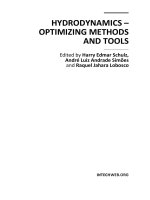Hydrodynamics Optimizing Methods and Tools Part 1 potx
Bạn đang xem bản rút gọn của tài liệu. Xem và tải ngay bản đầy đủ của tài liệu tại đây (1.76 MB, 30 trang )
HYDRODYNAMICS –
OPTIMIZING METHODS
AND TOOLS
Edited by Harry Edmar Schulz,
André Luiz Andrade Simões
and Raquel Jahara Lobosco
Hydrodynamics – Optimizing Methods and Tools
Edited by Harry Edmar Schulz, André Luiz Andrade Simões and Raquel Jahara Lobosco
Published by InTech
Janeza Trdine 9, 51000 Rijeka, Croatia
Copyright © 2011 InTech
All chapters are Open Access articles distributed under the Creative Commons
Non Commercial Share Alike Attribution 3.0 license, which permits to copy,
distribute, transmit, and adapt the work in any medium, so long as the original
work is properly cited. After this work has been published by InTech, authors
have the right to republish it, in whole or part, in any publication of which they
are the author, and to make other personal use of the work. Any republication,
referencing or personal use of the work must explicitly identify the original source.
Statements and opinions expressed in the chapters are these of the individual contributors
and not necessarily those of the editors or publisher. No responsibility is accepted
for the accuracy of information contained in the published articles. The publisher
assumes no responsibility for any damage or injury to persons or property arising out
of the use of any materials, instructions, methods or ideas contained in the book.
Publishing Process Manager Bojana Zelenika
Technical Editor Teodora Smiljanic
Cover Designer Jan Hyrat
Image Copyright André Luiz Andrade Simões, 2011.
First published September, 2011
Printed in Croatia
A free online edition of this book is available at www.intechopen.com
Additional hard copies can be obtained from
Hydrodynamics – Optimizing Methods and Tools, Edited by Harry Edmar Schulz,
André Luiz Andrade Simões and Raquel Jahara Lobosco
p. cm.
ISBN 978-953-307-712-3
free online editions of InTech
Books and Journals can be found at
www.intechopen.com
Contents
Preface IX
Part 1 Smoothed Spheres 1
Chapter 1 SmoothViz: Visualization of Smoothed
Particles Hydrodynamics Data 3
Lars Linsen, Vladimir Molchanov, Petar Dobrev, Stephan Rosswog,
Paul Rosenthal and Tran Van Long
Chapter 2 Using DEM in Particulate Flow Simulations
Donghong Gao and Jin Sun 29
Chapter 3 Hydrodynamic Loads Computation
Using the Smoothed Particle Methods 51
Konstantin Afanasiev, Roman Makarchuk and Andrey Popov
Chapter 4 Simulating Flows with SPH:
Recent Developments and Applications 79
Giacomo Viccione, Vittorio Bovolin
and Eugenio Pugliese Carratelli
Chapter 5 3D Coalescence Collision of Liquid Drops
Using Smoothed Particle Hydrodynamics 85
Alejandro Acevedo-Malavé and Máximo García-Sucre
Part 2 Models and Codes in Fluid Dynamics 107
Chapter 6 Eulerian-Lagrangian Formulation
for Compressible Navier-Stokes Equations 109
Carlos Cartes and Orazio Descalzi
Chapter 7 Lattice Boltzmann Modeling
for Melting/Solidification Processes 129
Dipankar Chatterjee
Chapter 8 Lattice Boltzmann Computations of Transport Processes
in Complex Hydrodynamics Systems 153
Zhiqiang Dong, Weizhong Li, Yongchen Song and Fangming Jiang
VI Contents
Chapter 9 Convergence Acceleration of Iterative Algorithms
for Solving Navier–Stokes Equations on Structured Grids 175
Sergey Martynenko
Chapter 10 Neural Network Modeling of Hydrodynamics Processes 201
Sergey Valyuhov, Alexander Kretinin and Alexander Burakov
Part 3 Complex Hydraulic Engineering Applications 223
Chapter 11 Interaction Between Hydraulic and Numerical Models
for the Design of Hydraulic Structures 225
Angel N. Menéndez and Nicolás D. Badano
Chapter 12 Turbulent Flow Around Submerged Bendway Weirs
and Its Influence on Channel Navigation 245
Yafei Jia, Tingting Zhu and Steve Scott
Chapter 13 Analysis of Two Phase Flows on Stepped Spillways 285
R. J. Lobosco, H.E. Schulz and A. L. A. Simões
Part 4 Hydrodynamics and Heat/Mass Transfer 309
Chapter 14 The Influence of the Hydrodynamic Conditions
on the Performance of Membrane Distillation 311
Marek Gryta
Chapter 15 Gas Hydrate Formation Kinetics in Semi-Batch
Flow Reactor Equipped with Static Mixer 335
Hideo Tajima
Chapter 16 Study of the Mass Transport on Corrosion
of Low Carbon Steel Immersed in Sour Solution
Under Turbulent Flow Conditions 353
R. Galvan-Martinez, R. Orozco-Cruz, J.Mendoza-Flores,
A. Contreras and J. Genesca
Chapter 17 Mass Transfer Performance of a Water-Sparged Aerocyclone
Reactor and Its Application in Wastewater Treatment 373
Xuejun Quan, Qinghua Zhao, Jinxin Xiang,
Zhiliang Cheng and Fuping Wang
Chapter 18 Hydrodynamical Simulation of Perspective Installations
for Electrometallurgy of Aluminium 395
A. S. Filippov, A. A. Kanaev, V. I. Kondakov and I. A. Korotkin
Preface
The Presence of Hydrodynamics in Modern Sciences: Optimizing Methods and Tools
“Water is the beginning of everything” (Tales of Mileto)
“Air is the beginning of everything” (Anaxímenes of Mileto)
Why is it important to study Hydrodynamics? The answer may be strictly technical,
but it may also involve some kind of human feeling about our environment, and our
(eventual) limitations to deal with its fluidic constituents.
As teachers, when talking to our students about the importance of quantifying
fluids, we (authors) go to the blackboard and draw, in blue color, a small
circumference in the center of the board, and add the obvious name “Earth”. Some
words are then said, in the sense that Hydrodynamics is important, because we are
beings strictly adapted to live immersed in a fluidic environment (air), and because
we are beings composed basically by simple fluidic solutions (water solutions),
encapsulated in fine carbon membranes. Then, with a red chalk, we draw two
crosses: one inside and the other outside the circumference, explaining: “our
environment is very limited. We can only survive in the space covered by the blue
line. No one of us can survive in the inner part of this sphere, or in the outer space.
Despite all films, games, and books about contacts with aliens, and endless journeys
across the universe, our present knowledge only allows to suggest that it is much
most probable that the human being will extinct while in this fine fluid membrane,
than to create sustainable artificial environments in the cosmos”.
Sometimes, to add some dramaticism, we project the known image of the earth on a
wall (the image of the blue sphere), and then we blow a soap bubble, explaining that
the image gives the false impression that the entire sphere is our home. But our
“home” is better represented by the liquid film of the soap bubble (only the film) and
then we touch the bubble, exploding it, showing its fragility.
In the sequence, we explain that a first reason to understand fluids would be, then, to
guarantee the maintenance of the fluidic environment (the film), so that we could also
guarantee our survival as much as possible. Further, as we move ourselves and
produce our things immersed in fluid, it is interesting to optimize such operations, in
order to facilitate our survival. Still further, because our organisms interchange heat
X Preface
and mass in cellular and corporal scales between different fluids, the understanding of
these transports permits to understand the spreading of diseases, the delivering of
medicines to cells, and the use of physical properties of fluids in internal treatments,
allowing to improve our quality of life. Finally, the observation of the inner part of
the sphere, the outer space and its constituents, shows that many “highly energetic”
phenomena behave like the fluids around us, giving us the hope that the knowledge
of fluids can help, in the future, to quantify, reproduce, control and use energy
sources similar to those of the stars, allowing to “move through the cosmos”, and
(only then) also to create sustainable artificial environments, and to leave this
“limited film” when necessary. Of course, this “speech” may be viewed as a sort of
escapism, related to a fiction of the future. In fact, the day-by-day activities show
that we are spending our time with “more important” things, like the fighting
among us for the dividends of the next fashion wave (or the next technical wave),
the hierarchy among nations, or the hierarchy of the cultures of the different nations.
So, fighters, warriors, or generals, still seem to be the agents that write our history.
But global survival, or, in other words, the guarantee of any future history, will need
other agents, devoted to other activities. The hope lies on the generation of
knowledge, in which the knowledge about fluids is vital.
Context of the present book “Hydrodynamics - Optimizing Methods and Tools”
A quick search in virtual book stores may result in more than hundred titles involving
the word “Hydrodynamics”. Considering the superposition existing with Fluid
Mechanics, the number of titles grows much more. Considering all these titles, why to
organize another book on Hydrodynamics? One answer could be: because the
researchers always try new points of view to understand and treat the problems
related to Hydrodynamics. Even a much known phenomenon may be re-explained
from a point of view that introduces different tools (conceptual, numerical or practical)
into the discussion of fluids. And eventually a detail shows to be useful, or even very
relevant. So, it is necessary to give the opportunity to the different authors to expose
their points of view.
Among the historically relevant books on Hydrodynamics, some should be
mentioned here. For example, the volumes “Hydrodynamics” and “Hydraulics”, by
Daniel Bernoulli (1738) and his father, Johann Bernoulli (1743), respectively, present
many interesting sketches and the analyses that converged to the so called
“Bernoulli equation”, later deduced more properly by Leonhard Euler. Although
there are unpleasant questions about the authorship of the main ideas, as pointed
out by Rouse (1967) and Calero (2008), both books are placed in a “prominent
position” in the history, because of their significant contributions. The volume
written by Sir Horace Lamb (1879), now named “Hydrodynamics”, considers the
basic equations, the vortex motion, tidal waves, among other interesting topics.
Considering the classical equations and procedures followed to study fluid motion,
the books “Fundamentals of Hydro and Aerodynamics“ and “Applied Hydro and
Aerodynamics“ by Prandtl and Tietjens (1934) present the theory and its practical
Preface XI
applications in a comprehensive way, influencing the experimental procedures for
several decades. Over fifty years, the classical volume of Landau and Lifschitz (1959)
remains as an extremely valuable work for researchers in fluid mechanics. In
addition to the usual themes, like the basic equations and turbulence, the book also
covers themes like the relativistic fluid dynamics and the dynamics of superfluids.
Each of the major topics considered in the studies of fluid mechanics can be widely
discussed, generating specific texts and books. An example is the theory of
boundary layers, in which the book of Schlichting (1951) has been considered an
indispensable reference, because it condenses most of the basic concepts on this
subject. Further, still considering specific topics, Stoker (1957) and Lighthill (1978)
wrote about waves in fluids, while Chandrasekhar (1961) and Drazin and Reid
(1981) considered hydrodynamic and hydromagnetic stability. It is also necessary to
mention the books of Batchelor (1953), Hinze (1958), and Monin and Yaglom (1965),
which are notable examples of texts on turbulence and statistical fluid mechanics,
showing basic concepts and comparative studies between theory and experimental
data. A more recent example may be the volume written by Kundu e Cohen (2008),
which furnishes a chapter on “biofluid mechanics” The list of the “relevant books” is
obviously not complete, and grows continuously, because new ideas are
continuously added to the existing knowledge.
The present book is one of the results of a project that generated three volumes, in
which recent studies on Hydrodynamics are described. The remaining two titles are
“Hydrodynamics - Natural Water Bodies”, and “Hydrodynamics - Advanced Topics”.
In the present volume, efforts to improve different methods that allow to understand
and optimize different processes and operations involving fluids are presented and
discussed. The editors thank all authors for their efforts in presenting their chapters
and conclusions, and hope that this effort will be welcomed by the professionals
dealing with Hydrodynamics.
The book “Hydrodynamics - Optimizing Methods and Tools” is organized in the
following manner:
Part 1: Smoothed Spheres
Part 2: Models and Codes in Fluid Dynamics
Part 3: Complex Hydraulic Engineering Applications
Part 4: Hydrodynamics and Heat/Mass Transfer
Hydrodynamics is a very rich area of study, involving some of the most intriguing
theoretical problems, considering our present level of knowledge. General nonlinear
solutions, closed statistical equations, explanation of sudden changes, for example, are
wanted in different areas of research, being also matter of study in Hydromechanics.
Further, any solution in this field depends on many factors, or many “boundary
conditions”. The changing of the boundary conditions is one of the ways through
which the human being affects its fluidic environment. Changes in a specific site can
impose catastrophic consequences in a whole region. For example, the permanent
leakage of petroleum in one point in the ocean may affect the life along the entire
XII Preface
region covered by the marine currents that transport this oil. Gases or liquids, the
changes in the quality of the fluids in which we live certainly affect our quality of life.
The knowledge about fluids, their movements, and their ability to transport physical
properties and compounds is thus recognized as important for life. As a consequence,
thinking about new solutions for general or specific problems in Hydromechanics may
help to attain a sustainable relationship with our environment. Re-contextualizing the
classical discussion about the truth, in which it was suggested that the “thinking” is
the guarantee of our “existence” (St. Augustine, 386a, b, 400), we can say that we agree
that thinking guarantees the human existence, and that there are too many warriors,
and too few thinkers. Following this re-contextualized sense, it was also said that the
man is a bridge between the “animal” and “something beyond the man” (Nietzsche,
1883). This is an interesting metaphor, because bridges are built crossing fluids (even
abysms are filled with fluids). Considering all possible interpretations of this phrase,
let us study and understand the fluids, and let us help to build the bridge.
Harry Edmar Schulz, André Luiz Andrade Simões and Raquel Jahara Lobosco
University of São Paulo
Brazil
References
Batchelor, G.K. (1953), The theory of homogeneous turbulence. First published in the
Cambridge Monographs on Mechanics and Applied Mathematics series 1953.
Reissued in the Cambridge Science Classics series 1982 (ISBN: 0 521 04117 1).
Bernoulli, D. (1738), Hydrodynamics. Dover Publications, Inc., Mineola, New York,
1968 (first publication) and reissued in 2005, ISBN-10: 0486441857.
Hydrodynamica, by Daniel Bernoulli, as published by Johann Reinhold Dulsecker
at Strassburg in 1738.
Bernoulli, J. (1743), Hydraulics. Dover Publications, Inc., Mineola, New York, 1968
(first publication) and reissued in 2005, ISBN-10: 0486441857. Hydraulica, by
Johann Bernoulli, as published by Marc-Michel Bousquet et Cie. at Lausanne and
Geneva in 1743.
Calero, J.S. (2008), The genesis of fluid mechanics (1640-1780). Springer, ISBN 978-1-
4020-6413-5. Original title: La génesis de la Mecánica de los Fluidos (1640–1780),
UNED, Madrid, 1996.
Chandrasekhar, S. (1961), Hydrodynamic and Hydromagnetic Stability. Clarendon
Press edition, 1961. Dover edition, first published in 1981 (ISBN: 0-486-64071-X).
Drazin, P.G. & Reid, W.H. (1981), Hydrodynamic stability. Cambridge University
Press (second edition 2004). (ISBN: 0 521 52541 1).
Hinze, J.O. (1959), Turbulence. McGraw-Hill, Inc. second edition, 1975 (ISBN:0-07-
029037-7).
Kundu, P.K. & Cohen, I.M. (2008), Fluid Mechanics. 4
th
ed. With contributions by P.S.
Ayyaswamy and H.H. Hu. Elsevier/Academic Press (ISBN 978-0-12-373735-9).
Preface XIII
Lamb, H. (1879), Hydrodynamics (Regarded as the sixth edition of a Treatise on the
Mathematical Theory of the Motion of Fluids, published in 1879). Dover Publications,
New York., sixth edition, 1993 (ISBN-10: 0486602567).
Landau, L.D.; Lifschitz, E.M. (1959), Fluid Mechanics. Course of theoretical Physics,
Volume 6. Second edition 1987 (Reprint with corrections 2006). Elsevier (ISBN-10:
0750627670).
Lighthill, J. (1978), Waves in Fluids. Cambridge University Press, Reissued in the
Cambridge Mathematical Library series 2001, Third printing 2005 (ISBN-10:
0521010454).
Monin, A.S. & Yaglom, A.M. (1965), Statistical fluid mechanics: mechanics of
turbulence. Originally published in 1965 by Nauka Press, Moscow, under the title
Statisticheskaya Gidromekhanika-Mekhanika Turbulentnosti. Dover edition, first
published in 2007. Volume 1 and Volume 2.
St. Augustine (386a), Contra Academicos, in Abbagnano, N. (2007), Dictionary of
Philosophy, “Cogito”, Martins Fontes, Brasil (Text in Portuguese).
St. Augustine (386b), Soliloquia, in Abbagnano, N. (2007), Dictionary of Philosophy,
“Cogito”, Martins Fontes, Brasil (Text in Portuguese).
St. Augustine (400-416), De Trinitate, in Abbagnano, N. (2007), Dictionary of
Philosophy, “Cogito”, Martins Fontes, Brasil (Text in Portuguese).
Nietzsche, F. (1883), Also sprach Zarathustra, Publicações Europa-América, Portugal
(Text in Portuguese, Ed. 1978).
Rouse, H. (1967). Preface to the english translation of the books Hydrodynamics and
Hydraulics, already mentioned in this list. Dover Publications, Inc.
Prandtl, L. & Tietjens, O.G. (1934) Fundamentals of Hydro & Aeromechanics, Dover
Publications, Inc. Ed. 1957.
Prandtl, L. & Tietjens, O.G. (1934) Applied Hydro & Aeromechanics, Dover
Publications, Inc. Ed. 1957.
Schlichting, H. (1951), Grenzschicht-Theorie. Karlsruhe: Verlag und Druck.
Stoker, J.J. (1957). Water waves: the mathematical theory with applications.
Interscience Publishers, New York (ISBN-10: 0471570346).
Part 1
Smoothed Spheres
0
SmoothViz: Visualization of Smoothed Par ticles
Hydrodynamics Data
Lars Linsen
1
, Vladimir Molchanov
1
, Petar Dobrev
1
, Stephan Rosswog
1
,
Paul Rosenthal
2
and Tran Van Long
3
1
Jacobs University, Bremen
2
Chemnitz University of Technology
3
University of Transport and Communication, Hanoi
1,2
Germany
3
Vietnam
1. Introduction
Smoothed particle hydrodynamics (SPH) is a completely mesh-free method to simulate
fluid flow (Gingold & Monaghan, 1977; Lucy, 1977). Rather than representing the physical
variables on a fixed grid, the fluid is represented by freely moving interpolation centers
(“particles”). Apart from their position and velocity these particles carry information about
the physical quantities of the considered fluid, such as temperature, composition, chemical
potentials, etc. As the method is completely Lagrangian and particles follow the motion of the
flow, the particles represent an unstructured data set at each point in time, i.e., the particles do
not exhibit a regular spatial arrangement nor a fixed connectivity. For a recent detailed review
of modern formulations of the SPH method see Rosswog (2009).
For the analysis of the simulation results, data visualization p lays an important role.
However, visualization methods need to account for the highly adaptive, unstructured data
representation in SPH simulations. Reconstructing the entire data field over a regular grid is
not an option, as it would either use grids of immense sizes that cannot be handled efficiently
anymore or it i nevitably would introduce significant interpolation errors. Such errors should
be avoided, especially as they would occur most prominently in areas of high particle density,
i.e., areas of highest importance are undersampled. Adaptive grids may be an option as
interpolation errors can be kept low, but the adaptivity requires special treatments during
the visualization process.
In this chapter, we introduce visualization methods that operate directly on the particle
data, i.e., on unstructured point-based volumetric data. Section 3 introduces an approach
to d irectly extract isosurfaces from a scalar field of the SPH simulation. Isosurfaces extraction
is a common visualization concept and is suitable for SPH data visualization, as one is often
interested in seeing boundaries of certain features.
Because of the use of radial kernel functions in SPH computations (which is crucial for
exact conservation of energy, momentum, and angular momentum) together with a poor
a resolution, one can observe that the extracted isosurfaces may be bumpy, especially in
regions of low particle density. We approach this issue by introducing level-set methods for
1
2 Will-be-set-by-IN-TECH
scalar field segmentation that include a smoothing term and extracting isosurfaces from the
smooth level-set function. A gain, the level-set method is only operating on the positions of
the par ticles and does not use any auxiliary grid to perform the computations. In Section 4,
we describe the general approach of smooth isosurface extraction from SPH data based on
level-set segmentation and in Section 5, we detail methods for improving the speed of the
level-set approach narrow-band processing, a local isosurface extraction approach based on
variational level sets, and a non-iterative second-order approximation of the signed distance
function which is needed throughout the level-set processing.
The surfaces that are extracted from p article data are in form of a point cloud representation.
Point-based rendering methods that display such surfaces without the necessity to first
generate a triangular mesh f rom the point clouds have become popular in computer
graphics within the last decades. We have developed an approach that uses image-space
operations to create desired renderings of large point clouds at interactive rates without
any pre-computations, i.e., not even computing neighborhoods of points. This property is
desirable, as we want to interactively extract different surfaces and display them immediately.
Section 6 provides the description of our approach including rendering features such as
transparency and shadows.
Since SPH simulations include a multitude of fields, it is of interest to investigate them
simultaneously and to explore their correlations. In Section 7, we investigate how multi-field
features can be detected and visualized. Detection is based on a clustering in the
multi-dimensional attribute space. The hierarchy of density clusters can be investigated using
coordinated views of the cluster tree, parallel coordinates of the multi-dimensional attribute
space, and a visualization of the volumetric physical space. The features are displayed in
physical space using surface extraction and rendering.
Finally, in Section 8, we explain how multiple scalar and volume fields can be explored
interactively using a visual system based on the methods described in this chapter. In
addition to the methods already mentioned, we support some further common visualization
functionality for scalar and vector fields.
2. Related work
In the astrophysics SPH community, visualization of slices through the volume, isosurface
extraction, direct volume rendering techniques, and particle rendering as color-mapped
points are most commonly used for the display of single scalar fields (Navratil et al., 2007;
Walker et al., 2005). A tool that provides such functionality (except for isosurfaces) is the freely
available visualization tool SPLASH (Price, 2007). The direct volume rendering is executed
by a ray casting approach, where integration along the rays is performed by integrating the
SPH kernel function. The high adaptivity of the SPH data forces one to use many rays to
not lose details in densely populated regions, which makes this purely software-based direct
volume rendering approach slow. Rotation, zooming, and similar desired features cannot
be achieved at interactive framerates (requiring about 20 frames per second). Navratil et al.
(2007) apply an inverse-distance-based interpolation for resampling the data to a regular grid
prior to isosurface extraction. Also, volume rendering approaches tend to resample over a
regular grid (Cha et al., 2009). However, due to the highly varying particle density (commonly
ten orders of magnitude), the precision of these approaches that resample over a static grid is
limited.
4
Hydrodynamics – Optimizing Methods and Tools
SmoothViz: Visualization of Smoothed Particles Hydrodynamics Data 3
The generation of tetrahedral meshes from particle data also has a l ong tradition.
Du & Wang (2006) give an overview over various approaches. Widely accepted are the
results given by Delaunay tetrahedrization (Delaunay, 1934), whose implementation is
also i ncluded into the Computational Geometry Algorithms Library (CGAL, 2011). More
recent approaches try to improve existing Delaunay tetrahedrization algorithms with
respect to robustness, quality, and efficiency. Robustness against numerical errors during
Delaunay insertion (Pav & Walkington, 2004) or for boundary recovery (Sapidis & Perucchio,
1991) is desired. Quality criteria with respect to some design goals are often
ensured by post-processing steps (Maur & Kolingerová, 2001). The incremental insertion
method (Borouchaki et al., 1995; George et al., 1991) is one of the most efficient
implementations. Still, computational costs are high. Co & Joy (2005) presented an
approach for isosurface extraction from point-based volume data that uses local Delaunay
triangulations, which keeps the number of points for each Delaunay triangulation step low
and thus improves the overall performance. An approach that also operates locally, but is
not based on tetrahedral meshes is given by Rosenberg & Birdwell (2008). They presented
an approach based on extracting isosurfaces while marching through slices, which works
at interactive rates for smaller number of particles. Our approach (Rosenthal & Linsen,
2006) was the first to extract isosurfaces directly from SPH data, which still outperforms the
algorithms listed above.
In terms of volume rendering approaches, splatting of transparent particle sprites is a popular
technique (Fraedrich et al., 2009; Hopf & Ertl, 2003; Hopf et al., 2004). A slice-based approach
was presented by Biddiscombe et al. (2008). The approach that is closest t o the volume
rendering approach we propose in here is the work by Fraedrich et al. (2010). Instead of
reconstructing the field on a static grid, they use a view-dependent grid. Hence, when the
viewing parameters change, the reconstruction is recomputed, which allows for application
to the highly adaptive structure of SPH data.
For the visualization of flow fields, direct and 2D streamline visualization methods are
supported by the SPH data visualization tool SPLASH (Price, 2007). Other flow visualization
methods for SPH data rely on reconstructing over a grid or on extracting and displaying
integral lines using the SPH kernel. Schindler et al. (2009) make use of the SPH kernel
by presenting a method for vortex core line extraction which operates d irectly on the SPH
representation. I t generates smoother and more spatially and te mporally coherent results.
The underlying predictor-corrector scheme is specialized for several variants of vortex core
line definitions.
3. Direct isosurface extraction
Isosurface extraction is a standard visualization method for scalar volume data and has been
subject to research for decades. We proposed a method that directly extracts surfaces from
SPH simulation data without 3D mesh generation or reconstruction over a structured grid
(Rosenthal, 2009; Rosenthal & Linsen, 2006; Rosenthal et al., 2007). It is based on spatial
domain partitioning using a kd-tree and an indexing scheme for efficient neighbor search.
In every point in time, the result of an SPH simulation is an unstructured point-based volume
data set. More precisely, it is a set of trivariate scalar fields f : R
3
→ R, whose values are given
for a large, finite set of sample points x
i
, whose positions are unstructured, i.e., they are not
arranged in a structured way, nor are any connectivity or neighborhood informations known
for the sample point locations. To visualize such a scalar field, our intention is to extract an
5
SmoothViz: Visualization of Smoothed Particles Hydrodynamics Data
4 Will-be-set-by-IN-TECH
isosurface Γ
iso
= {x ∈ R
3
: f (x)=v
iso
} with respect to a real isovalue v
iso
out of the range
of f .
Our approach consists of a geometry extraction and a rendering step. The geometry extraction
step computes points p
k
∈ R
3
on the isosurface, i.e., f (p
k
)=v
iso
, by linearly interpolating
between neighbored pairs of samples. The neighbor information is retrieved by partitioning
the 3D domain into cells using a kd-tree. The cells are merely described by their index and
bit-wise index operations allow for a fast determination of potential neighbors. We use an
angle criterion to select appropriate neighbors from the small set of candidates. The output of
the geometry step is a point cloud representation of the isosurface. The final rendering step
uses point-based rendering techniques to visualize the point cloud.
In the following, all integers indexed with d, such as a
d
or 100
d
denote binary numbers. The
operator
⊕ denotes the bitwise Boolean exclusive-or operator. Finally, the operators and
denote the bit-shift operators, which are recursively defined by
0. a
d
0 = a
d
and a
d
0 = a
d
.
1. a
d
j =(a
d
(j − 1)) ∗ 2.
2. a
d
j =(a
d
(j − 1)) div 2.
The indexing scheme of the kd-tree represents its construction. The father of node with binary
index b
d
has index b
d
1 and its children have indices b
d
1and(b
d
1) ⊕ 1
d
.Figure1
shows a 2D example. Thus, we can navigate through the tree using fast binary operations.
Moreover, qualitative propositions about the locations of cells can be made. For instance
the cells with index 1111
d
and 1000
d
lie in diagonally distant corners of the kd-tree. Thus,
most information is implicitly saved in the indexing scheme. We exploit this property for fast
neighbor search.
Fig. 1. Indexing scheme for two-dimensional kd-tree.
For validation, we have applied our approach to a sphere data set, which consists of randomly
distributed sample points in a 200
× 200 × 200 cube. The sample values describe the distance
to the center of a sphere. We extract an isosurface from the distance field using isovalue 70.
The generated and rendered sphere can be seen in Figure 2. Our direct isosurface extraction
algorithm for scattered data produces results of quality close to the results from standard
isosurface extraction algorithms for gridded data (like marching cubes). In comparison to
3D mesh generation algorithms (like Delaunay tetrahedrization), our algorithm is about one
order of magnitude faster for our examples.
4. Smooth isosurface extraction
SPH uses radial smoothing kernels since they ensure the exact conservation of the physically
conserved quantities (Rosswog, 2009). This has as a side effect that the particles are constantly
re-adjusting their positions which can lead to “noise” in the particle velocities. Moreover,
6
Hydrodynamics – Optimizing Methods and Tools
SmoothViz: Visualization of Smoothed Particles Hydrodynamics Data 5
Fig. 2. Isosurface extracted from an example 16M particles.
in particular in sparsely sampled regions the radial kernels can produce some “bumpiness”
when direct isosurface extraction from SPH scalar fields is applied. Figure 3(a) shows the
result of direct isosurface extraction from SPH data. Here, points on the extracted isosurface
are rendered as circular splats to show the noise issue. Hence, it is desirable to add a
controllable smoothing term to the isosurface extraction procedure. Smooth surface extraction
using partial differential equations (PDEs) is a well-known and widely used technique for
visualizing volume data. Existing approaches operate on gridded data and mainly on regular
structured grids. When considering unstructured point-based volume data, where sample
points do not form regular patterns nor are they connected in any form, one would t ypically
resample the data over a grid prior to applying the known PDE-based methods. We proposed
an approach that directly extracts smooth surfaces from unstructured p oint-based volume
data without prior resampling or mesh generation (Rosenthal & Linsen, 2008b).
When operating on unstructured data one needs to quickly derive neighborhood information,
which we retrieve from the kd-tree. We exploit neighborhood information to estimate
gradients and mean curvature at every sample point using a four-dimensional least-squares
fitting approach. This procedure finally results in a closed formula for the gradient
approximation. For a one-dimensional function ϕ, represented through the points
(x
1
, ϕ
1
), ,(x
n
, ϕ
n
),weget
dϕ
dx
=
n
n
∑
i=1
x
i
ϕ
i
−
n
∑
i=1
x
i
n
∑
i=1
ϕ
i
n
n
∑
i=1
x
2
i
−
n
∑
i=1
x
i
2
.(1)
It can be shown that this scheme is a generalization of common finite differencing schemes.
Having gradients ∇ϕ of the level-set function ϕ and mean curvature κ
ϕ
computed, one can
apply a PDE-based method that combines hyperbolic advection to an isovalue of a given
scalar field and mean curvature flow. A time step is performed with respect to the equation
∂ϕ
∂t
=
a
(
f − f
iso
− ϕ
)
+
bκ
ϕ
|
∇
ϕ
|
,(2)
which models hyperbolic normal advection, weighted with factor a
> 0, and mean curvature
flow, weighted with factor b
> 0. This leads to a level-set segmentation algorithm. Since we
are solving a partial differential equation by means of an explicit time integration scheme, the
7
SmoothViz: Visualization of Smoothed Particles Hydrodynamics Data
6 Will-be-set-by-IN-TECH
time step is restricted by the Courant-Friedrichs-Lewy (CFL) stability criterion Courant et al.
(1928). Due to different conditions in different parts of the fluid, the allowed time steps can
vary considerably between different particles. In order to avoid the computational burden
of advancing all particles globally on the shortest allowed time step, one can also advance
different elements on their own individual time steps, a technique that is commonly used in
expensive SPH simulations.
We extract a smooth surface by successively fitting a smooth level-set function to the data set.
This level-set function is initialized as a signed distance function. For each sample and for
every time step we compute the respective gradient, the mean curvature, and a stable time
step. With this information the level-set function is manipulated using an explicit Euler time
integration. The process successively continues with the next sample point in time. If the
norm of the level-set function gradient in a sample exceeds a given threshold at some time,
the level-set function is reinitialized to a signed distance function. After convergence of the
evolution, the resulting smooth surface is obtained by extracting the zero isosurface from the
level-set function using direct isosurface extraction from unstructured point-based volume
data (as described above) and rendering the extracted surface using point-based rendering
methods. Figure 3(b) shows the result of our smooth isosurface extraction for the same data
set as in Figure 3(a) and using the same splat-based rendering method. It can be observed that
the objective of extracting a smooth version of an isosurface has been achieved (especially in
the zoomed-in view).
(a)
(b)
Fig. 3. Comparison between (a) direct isosurface extraction and (b) smooth isosurface
extraction for an SPH simulation data set.
5. Acceleration of smooth isosurface extraction
5.1 Narrow-band processing
The global processing of the level-set function can be slow when dealing with unstructured
point-based volume data sets containing several million data points. We developed an
improved level-set approach that performs the process of the level-set function locally
8
Hydrodynamics – Optimizing Methods and Tools
SmoothViz: Visualization of Smoothed Particles Hydrodynamics Data 7
(Rosenthal et al., 2010). Since for isosurface extraction we are only interested in the zero
level set, values are only up dated in regions close to the zero level set. In each iteration
of the level-set process, the zero level set is extracted using direct isosurface extraction
from unstructured point-based volume data and a narrow band around the zero level set
is constructed. The band consists of two parts: an inner and an outer band. The inner band
contains all data points within a small area around the zero level set. These points are updated
when executing the level-set step. The outer band encloses the inner band providing all those
neighbors of the points of the inner band that are necessary to approximate gradients and
mean curvature. As before, neighborhood information is obtained using an efficient kd-tree
scheme, gradients and mean curvature are estimated using a four-dimensional least-squares
fitting approach.
The construction of the two-layer band around the zero level set is shown in Figure 4. The zero
level set (colored blue) is extracted in form of a point cloud representation. Then, all sample
points with distance to the zero level set less than a distance d
α
are marked as belonging to
the inner layer of the band (green). Thereafter, all additional sample points needed for the
gradient computations within the level-set process are marked as belonging to the outer layer
of the band (red points). All other sample points (grey) are not used for the current level-set
step. The distance d
α
can be estimated using the CFL condition that bounds the level-set step.
Fig. 4. Narrow-band construction for more efficient level-set processing.
How the level-set function is updated after having executed a level-set iteration on the
narrow band with size d
α
is shown in F igure 5: Points (green) with minimum distance to
the zero-level-set points (blue) smaller than
d
α
4
have been in the α-band in the preceding time
step and, thus, their level-set function values have been updated in the level-set iteration step.
Points (red) in the outer band or with distance to the zero level set greater than
d
α
2
might have
not be included in the computations of the last level-set iteration step. We assign their level-set
function value to the signed distance to the zero-level-set points. For all points in the α-band
with a distance to the zero level set in the range
d
α
4
,
d
α
2
, the new level-set function value is
interpolated between the level-set function value from the preceding level-set step and their
signed distance to the zero-level-set points.
9
SmoothViz: Visualization of Smoothed Particles Hydrodynamics Data
8 Will-be-set-by-IN-TECH
$\f
r
$\f
r
d
α
4
d
α
2
Fig. 5. Narrow-band update during level-set procedure (d
α
denotes the size of the narrow
band).
For performance analysis we applied it t o an unstructured point-based volume data set with
eight million randomly distributed samples. The data set was generated by resampling the
regular Hydrogen data set of size 128
× 128 × 128 to the random points. Illustrations of the
evolution process for this data set are shown in Figure 6 (Data set courtesy of Peter Fassbinder
and Wolfgang Schweizer, SFB 382 University Tübingen.). For each time step, a splat-based
ray tracing of the zero level set is shown on the right-hand side. On the left-hand side, a point
rendering of a slab of the data set is shown illustrating the narrow band. Extracted surface
points of the zero level set are colored black, sample points in the α-band are colored green,
and sample points in the outer band are colored red. Sample points not belonging to the
narrow band are not rendered.
The whole local level-set process for extracting a smooth isosurface from the Hydrogen data
set with eight million sample points and given nearest neighbors needed 24 steps and was
performed in 6 minutes. For the four million version of the data set, the overall computation
time for the entire level-set approach including pre-computations d ropped to 84 seconds.
This is a significant speed-up in comparison to the time of 13 minutes needed without
the narrow-band processing. Still, it produces equivalent results in terms of quality and
correctness.
5.2 Variational level-set detection of local isosurfaces
Another acceleration of the level-set approach can be achieved by only operating locally on a
region of interest. We derived a variational formulation for smooth local isosurface extraction
using an implicit surface representation in form of a level-set approach, deploying a moving
least-squares (MLS) approximation, and operating on a kd-tree (Molchanov et al., 2011). The
locality of our approach has two aspects: First, our algorithm extracts only those components
of the isosurface, which intersect a subdomain of interest. Second, the action of the main
term in the governing equation is concentrated near the current isosurface position. Both
aspects reduce the computation times per level-set iteration. As for most level-set methods
a reinitialization procedure is needed, but we also consider a modified algorithm where this
step is eliminated. The final isosurface is extracted in form of a point cloud representation.
10
Hydrodynamics – Optimizing Methods and Tools
SmoothViz: Visualization of Smoothed Particles Hydrodynamics Data 9
Step 9 Step 15
Step 21 Step 24
Fig. 6. Narrow-band level-set evolution.
We also presented a novel point completion scheme that allows us to handle highly adaptive
point sample distributions.
A variational approach is used to derive the local level-set updates. We start w ith a
construction of an error functional E, which is the target function that we want to minimize.
The error depends o n the given data f , the constant f
iso
representing the isovalue, and a
level-set function ϕ together with its derivatives of first order, i.e., E
= E(ϕ, ∇ϕ; f , f
iso
).The
total error consists of two weighted terms
E
= E
1
+ λE
2
,(3)
measuring accuracy and smoothness of the solution, respectively. We propose to use
E
1
=
1
4
D
(sgn(ϕ(x)) − sgn( f (x) − f
iso
))
2
dx,(4)
and
E
2
=
D
δ(ϕ(x)) |∇ϕ(x)| dx.(5)
Here, we use the standard definitions of the sign function sgn
(x) and the Dirac function δ(x)
and the derivative is used in the sense of distributions.
Afunctionϕ
∞
minimizing some functional of the form
L(ϕ, ∇ϕ) dx should satisfy the
Euler-Lagrange equation
∂L
∂ϕ
−
∑
i
∂
∂x
i
∂L
∂ϕ
i
ϕ=ϕ
∞
= 0, (6)
11
SmoothViz: Visualization of Smoothed Particles Hydrodynamics Data









